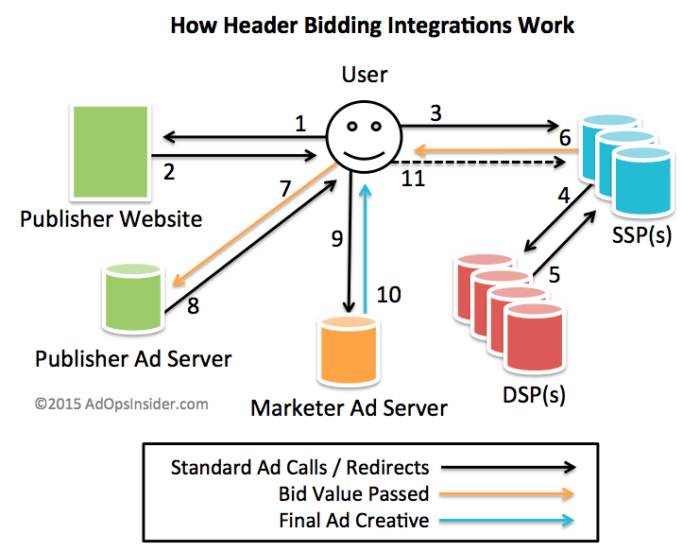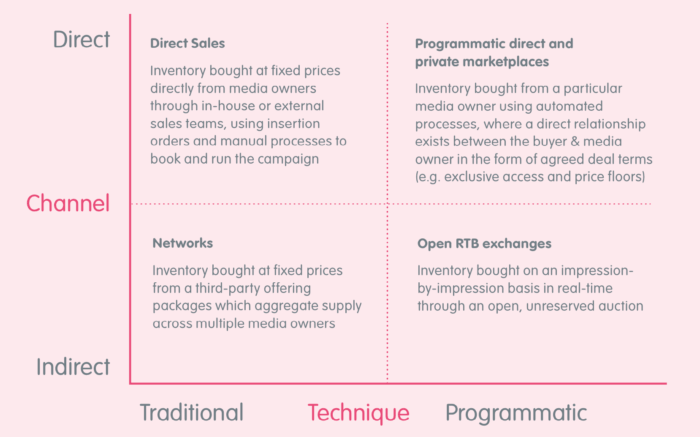In the more than 15 years since its inception, programmatic marketing has truly delivered on its original promise of being the future of web advertising. But what exactly is programmatic marketing nowadays?
Programmatic marketing, which is now an essential component of most omnichannel marketing strategies, is a term used to describe the complex use of data and machine learning to enable hyper-segmentation based on your customers’ behavior.
The exciting aspect of programmatic advertising is that as technology advances, marketers are exposed to an increasing number of opportunities to find and engage their key customers. As a result, programmatic marketers will need to stay alert to keep up with the latest trends and innovations.
Furthermore, with iPhone’s upcoming privacy policy changes, it pays to plan ahead of time when planning your advertising activities.
Programmatic marketing is becoming more popular in today’s digital age. Programmatic digital display ad spending in the United States is expected to increase by more than a third by 2023, reaching $133.04 billion.

The last five years have seen tremendous programmatic growth. Global programmatic advertising spend is more than double what it was five years ago, and is expected to reach $155 (US) in 2021.
Definition of Programmatic advertising:
According to the Digital Marketing Institute, a simple definition of programmatic advertising is:
“The purchase of digital advertising through the use of the software.”
Programmatic marketing refers to the distribution of advertisements when humans are not directly involved in the process. So, if we talk about Targeted Programmatic Display Advertising, we’ll be clearer about Programmatic Marketing. This is something I try to do, but many people don’t.
Check out the FAQs below:
Q. Is Programmatic Marketing limited to Programmatic Advertising?
Ans. Yes, it is.
We must be cautious here because it only refers to paid advertising and not other forms of automation such as web personalization or email marketing, which are both parts of marketing automation. So, how do we respond to this question?
Programmatic has grown rapidly because it is much more efficient for advertisers and media agencies managing their budgets. Before Programmatic, a publisher had to call an advertiser, negotiate terms for various ad inventory values, and use a manual insertion order process before purchasing. Ad exchanges have entirely transformed the process of selling and buying programmatic advertising.
Q. Is ad spend on Google Ads (paid search) included in programmatic?
Ans. No. All paid search is not included in programmatic advertising (and classified). It can be perplexing because, as you may know, Google Ads includes both ads placed in response to search engine queries as well as YouTube Ads and Google’s display network.
Q. How do I stay updated on programmatic advertising best practices?
Ans. Smart Insights members are taking advantage of our Learning Paths marketing training to stay up to date on the latest digital trends. Our advanced module ‘forecast results and ROI for digital marketing activities’ includes marketing tools for optimizing your programmatic marketing strategy and tactics.
This module will walk you through the process of managing all of your key digital marketing channels, including programmatic advertising, step by step.
Q. Is programmatic buying always done through ad exchanges?
Ans. Yes.
Ads were (and still are) sold through ad networks, with no price control for publishers. Ad exchanges now bring together publishers, advertisers, agencies, and networks in one place to sell and buy ad impressions in a fully automated process.
This diagram summarises the process of an ad marketplace, which connects Demand Side Platforms (DSPs) on the left with Sell-side Platforms (SSPs) on the right.
It’s easier to understand the process if you read it from right to left, beginning with the consumer:
- In the browser; the consumer loads a page from the publisher’s website ( such as a car magazine website.)
- The publisher’s ad server notifies the SSP that ad inventory is available.
- DSPs notify advertisers (for example, car manufacturers) via an ad network linked to a trading desk. And it selects inventory based on the type of consumer they want to advertise to and the bids they have set.
Q. Is real-time programmatic advertising purchased?
Ans. Yes, it is. This is yet another feature of programmatic advertising. This is why the diagram refers to RTB (real-time bidding) and, increasingly, header bidding, which is another term used to describe Programmatic display advertising.
Q. Is header bidding used in programmatic?
Ans. Not necessarily, but it’s become a more popular technique among large advertisers since 2016.
The website media owner or publisher places a line of JavaScript in the website’s header to bid on. When a page on the site is loaded, the code solicits bids from the supported ad exchanges or supply-side platforms (SSPs) before calling its ad server. Bidding is essentially simultaneous rather than sequential, and it focuses on all available impressions rather than just those available following direct sales.
This 2015 AdopsInsider visual explains the process. Although the processes have many more variables today, the basic journey of the ad from marketer to the user remains the same.

Q. So programmatic is only about bidding on ad marketplace platforms?
Ans. No, it does not. This is what is commonly referred to as programmatic, but media can also be purchased directly from advertisers or through private marketplaces. As this figure from the IAB Programmatic Handbook (direct download) shows, on the right, there are two options: private marketplaces and open Real-time buying exchanges (RTB).

Header Bidding recommends the following programmatic ad exchanges to publishers:
- DoubleClick (Google Ad Exchange)
- AppNexus
- Smarty Ads
- Smaato
- Rubicon Project
- PubMatic
- Index Exchange
- OpenX
Google AdX, the world’s largest programmatic ad exchange, holds the first-price auction and sells real-time display advertising space. It is the premium version of Google AdSense for larger publishers; as opposed to AdSense for smaller publishers.
Because ‘Programmatic Marketing’ or advertising is such a broad term, it’s best to categorize it based on whether or not it uses Real-time Bidding (RTB). Bidding is frequently regarded as a real-time transaction. This summary, also from the Magna Global report, helps demonstrate the differences.
What is the process of programmatic marketing?
When someone clicks on a web page with programmatic advertising space, the publisher of the page places an ad impression up for auction in an ad marketplace. The ad marketplace then holds an auction among advertisers who want to show an ad to the specific customer who just clicked on the page. There may be several advertisers competing in this auction, and whoever is willing to bid the most ultimately wins the auction, and their ad is displayed to the customer when the page loads.
The auction can be completed in the milliseconds it takes for the page to load because the process is automated, and the maximum price each advertiser is willing to bid for the impression has already been programmed in. Our easy-to-understand infographic walks you through six steps that explain how programmatic marketing works.
The advantages of programmatic marketing:
- Programmatic marketing opens up plenty of possibilities that would not have been possible if ad placement had been done manually in the past.
- It enables advertisers to acquire digital media without having to pre-negotiate a price. So, they pay only for the relevant impressions that they receive.
- They can also sign up for a minimum number of impressions or a minimum budget, making digital advertising more flexible. And they can buy digital media from multiple publishers, lowering administration costs.
- However, the opportunities go far beyond simply making ad buying easier and more flexible.
- Because of programmatic marketing, marketers can target people to a much greater extent than before. It means bids are arranged for each accessing the site.
- Programmatic technology can identify what resonates with each individual and target them on the sites and at the times they are most likely to engage with.
All in all:
Programmatic marketing has countless benefits. Using it smartly will surely help you to earn more profits. Don’t know how to use it? Hire the best digital marketing company. It has professionals and experts who are in the same business for a long time, and they know how to use the different marketing strategies to bring about fruitful results.






